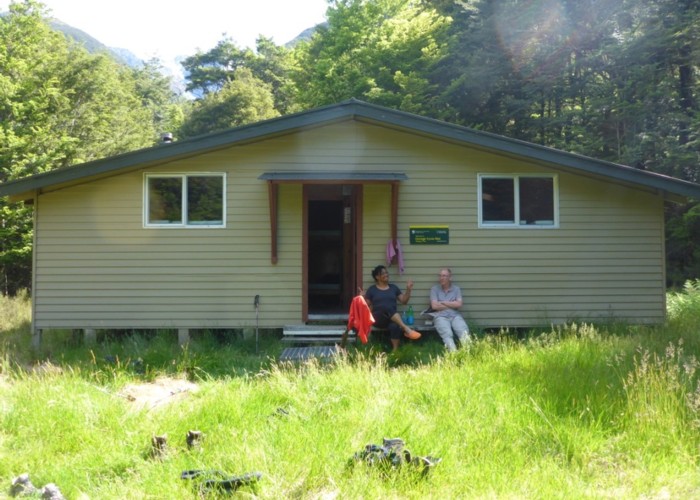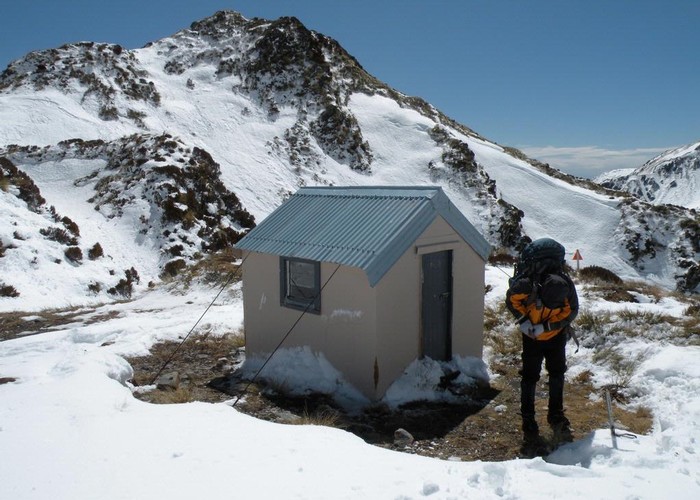by @PhillipW
For overseas visitors to the kiwi backcountry our hut system is the most visible aspect of the local tramping and hunting culture. Almost all of them are unlocked and are there to provide shelter for any genuine people who need to stay. But some of our huts are getting very well used indeed, sometimes too much. This is a guide to understanding and using them so as you will be a welcome guest.
There are about 900 or more huts, ranging from tiny 2 person ‘dogbox’ bivvies’ which you can only just sit up in, to massive 80 or more bunk facilities you will find on the Great Walk system. However most are modest 4 – 6 bunkers of a very basic – but well liked design – that date from the period when they were built by a government body for animal and pest control work. These are called “Forest Service Six Bunkers”. They may look plain, their beds are hard, their fireplace and bench utilitarian – but this does not mean they are ordinary to us.
Choose a hut
Others were originally built by local alpine, tramping or hunting clubs, who usually to this day continue to maintain them for the sheer love of it. And there are a scattering of even older huts built for all manner of purposes – to a diversity of sometimes quirky designs. Most are now legally administered by the Department of Conservation (DoC) who inherited ownership of them when all the various Parks, Forests and Reserves were brought together about 30 years ago.
{{14602}}
Each hut has something of a story to tell about who built it and why. But they all have two things in common. There is a local community who treasure them and who works in partnership with DoC to manage them; and they are open for you to stay in as our guests. If you are in one of our huts on a cold, wet night we hope that you too experience something of the enveloping, embracing shelter from the storm which so endears these modest, humble places to us.
Away from the lodges on the Great Walks and a handful of other high use facilities – there is no booking system. You are expected to make welcome anyone else who arrives and share with them. Often you may have the hut all to yourselves, but it’s not unusual to find 20 or more people crammed into a six bunk hut. It’s a squeeze alright, but it is also an experience worth making the most of.
For a start all the bunks beds will top and toe. Then you can easily fit another 6 – 8 on the floor. If there is a porch – another group of 6 – 10 might fit out there on a not too wet night. Or after getting dry and cooking a meal, another group might camp out nearby for the night. This is why it’s a good idea to carry some form of lightweight shelter in the event the hut is a little too crowded that night.
The important rules are courtesy, respect and cooperation. Oh and it’s a good idea to have your Back Country Hut Pass ticket visible on the outside of your pack. It shows that you aren’t a freeloader – and the locals will appreciate you playing by the rules.
Making an entry into the Hut Book is part of the culture too. Apart from being very helpful to the Search and Rescue (SAR) people if they do need to come looking for you – the Hut Book is an important tramping tradition. Many people read back over the old entries, looking for mates, unusual weather or changes to the tracks and tales of epic misadventures.
In a busy hut you’ll want to be organised with your gear and cooking. There’s a lot going on in a small space and consideration for others will make you welcome. Don’t be shy of talking to people. There is every chance to strike up a warm and interesting conversation, play cards, stargaze, read a book, write up your journal or just lie there quietly people watching, enjoying a social moment most of us rarely experience in this modern world.

Keep wet boots and gear outside. Most kiwi trampers carry light pair of ‘hut sandals’ that are easy to slip on and off. Earplugs are a great idea, not only for the inevitable snorers, but the rustlings of tossers and turners, the midnight snackers and toilet trotters. Or the wind-driven rain rattling in the roof and crashing in the trees.
Toilets - almost every overnight shelter has one, they are not often the flush versions now being installed at lodges but even the most basic outhouse over a smelly hole is appreciated on a dark windy wet night. Bring your own toilet paper. Do clean the seat and surrounds when needed. Do NOT use for garbage disposal.
Rubbish - wrappers, bottles, paper, fuel containers, surplus food ... if you carried it in its your responsibility to carry it out. Leaving food of any sort behind, with any excuse, is almost always a way to feed the rats and mice. Paper and cardboard can sometimes be burnt, but do it yourself and deal with the inevitable melted plastic and scraps of aluminum by carrying them out.
Turning on your 10,000 Lumen, drop possums at 200m LED torch, in the middle of the night is considered very anti-social. Get one with a nice dim red setting that you can get to with one push on the switch.
Leaving is your last and best moment to respect the hut and give something back. Your hut wants to be clean and tidy – ready for the next group coming to visit. Put the hut book back in its place, clean up the bench and fireplace, sweep out the floor. Prop up the bunk mattresses to let air circulate around them. If you used up a lot of dry firewood it’s going to need replacing. It’s not the ‘wood fairies’ who do it! One last check for left behind oddments – secure the door behind you – and off.

